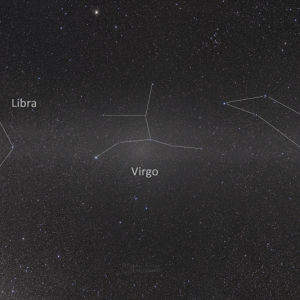All of the Zodiacal Light
Description
From the photographer: “This of the entire Zodiacal Light from dusk to dawn was taken from the platforms of Gemini South in Chile (left) and Gemini North in Hawai‘i (right), the two telescopes comprising the International Gemini Observatory, a Program of NSF’s NOIRLab. Since both platforms provide unique observational conditions in high altitudes (Gemini South at 2722 m, Gemini North at 4214 m), it is possible to see and capture even the faint structures of the Zodiacal Light. This bright white band is created by sunlight scattering off interplanetary dust dispersed throughout the Solar System. This light appears along the pathway of the Sun and planets across the sky, known as the ecliptic (where the constellations of the Zodiac appear as well, thus the name), and it’s so bright that it can easily be mistaken for light pollution on a dark night. The bright patch of light at the center of the image is directly opposite the Sun in the sky. This spot is the Gegenschein. On the left side of the image, you can zoom in to see a rising Jupiter along with Venus (the brightest spot on the left), Mars, and Saturn. The dust that produces the Zodiacal Light and Gegenschein comes from a variety of sources, including dusty comet tails and asteroid collisions. Interestingly, Mars may actually produce a large portion of this dust as it sheds its atmosphere, based on recent studies. Taken from both hemispheres to avoid the slope of the ecliptic, this could be the most complete Zodiacal Light panorama.
The image was taken from both hemispheres at the beginning of April 2022, which required perfect timing of the Moon phase but also quick traveling. The photography was very difficult (and the resulting image is not perfect so far), especially due to the very strong wind at Mauna Kea, while the southern part was taken during incredibly strong airglow, and for this image, I had to create very specific false flatfield to subtract the structures and colors of the airglow and volcanic dawn. While the northern (right) part was mostly taken on April 2nd evening, the southern (left) was on April 6th morning… So 3,5 days are different, which is almost nothing considering the movement of the Gegenschein in the sky. This is, however, the reason why it was so crucial to have good weather last night at Mauna Kea and the first night at Cerro Pachón. Crucial was also the Moon phase, which was favorable for the project just around these days (no Moon in the evening from Mauna Kea and then no Moon in the morning from Cerro Pachón). Click on second photo for annotation.”
Full credit of the image: NOIRLab/NSF/AURA/ Petr Horálek (Institute of Physics in Opava), Tomáš Slovinský.
Technical details: A panorama of 21 segments, each segment is a stacked image of 60×30 seconds frames captured with Canon Ra and Samyang 24 mm, f set to 2.2, ISO 4000, used Vixen Polarie U.


comments (0)